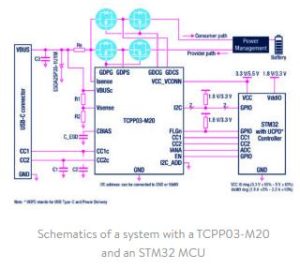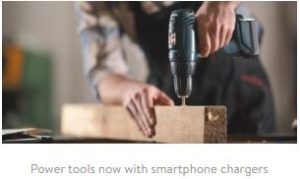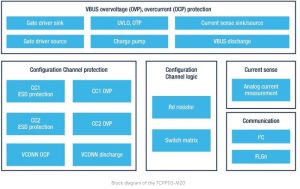The TCPP03-M20 is ST’s first USB-C port protection device for dual role power (DRP) applications, meaning that it will serve systems designed as a source (charger) or a sink (charging). In the most simplistic terms, the component brings together the TCPP01-M12 (sink) and the TCPP02-M18 (source) featured on the ST Blog. For instance, it includes their gate drivers to protect against over-voltage and over-current on the VBUS. Similarly, the TCPP03-M20 embeds the same current sensing element as the TCPP02-M18 and an identical discharge path on the VBUS and VCONN. However, it also includes power consumption states to help engineers optimize the applications that are clamoring for dual-role power protection.
The Rise of Hybrid Applications
Why Dual-Role Ports Are a Flagship Feature?
Hybrid applications, which mix charging an internal battery and then using that battery to charge a mobile product like a smartphone, are becoming flagship features. For instance, external batteries are getting smaller. Previously, makers would dedicate one port to charge the internal battery and another to charge external products. To save space and improve the user’s experience, engineers now use a single dual-role port for both roles. Similarly, manufacturers are adding USB-C ports to products that previously didn’t have any. For instance, batteries for power tools use dual-role power ports to increase their appeal. Consumers can use the port to charge the internal battery and charge smartphones or tablets when in the field.
Where Did the Trend Originate?
The new market trends seem to respond to consumer demands rather than legislation. Indeed, the TCPP01-M12 and TCPP02-M18 offer solutions to the unique challenges brought by the European Union’s decisions to harmonize charging ports. As products all use USB-C, it is critical to protect against edge cases and poorly designed systems. Yet, the rise of dual-role power applications doesn’t come from European regulations. Instead, manufacturers are finally implementing a long-standing promise of the USB-IF. Indeed, the Forum first introduced the DRP as early as 2016 during a developer’s conference. Since then, the press has been promoting this feature. Manufacturers are now able to deliver it to consumers.
TCPP03-M20 and the Challenges of Dual-Role Power Ports
Why Does Dual-Role Port Protection Needs More Power?
Releasing hybrid applications took time partly because designing a system supporting sink and source is tricky. In essence, a USB-C port in a sink mode will use a pull-down resistor while a source component will rely on a pull-up resistor, and a dual role connector will switch between the two. However, while the fundamentals are straightforward, engineers face optimization challenges to create efficient systems. For instance, designing a PCB with a large external USB-PD controller supporting DRP often means that the protection device will often draw more than 15 µA when there’s no cable attached. Indeed, the protection device must be ready for both a source and a sink application until it can make a determination.
How Does a Companion Chip Help Improve Efficiency?
The TCPP03-M20 offers new solutions to the power consumption challenges because it works as a companion device with the USB PD controller found inside STM32 microcontrollers. The embedded nature of the solution means fewer external components and greater coordination with the processor. For instance, the protection device can use a hibernate mode by default when no cable is attached. The I2C interface is active, allowing the microcontroller to send commands, but the protection device doesn’t consume any power. Indeed, our tests show a power consumption of 0 µA, without accounting for the dynamic current of the I2C interface.
Similarly, the TCPP03-M20 includes a low-power mode that demands only 3 µA in an unattached state at 1.8 V, and 10 µA at 3.3 V. In that power mode, the component offers over-voltage protection but doesn’t allow for communication with the USB-C PD controller yet. It is thus a way for engineers to increase efficiency while waiting for user interactions. The system is ready to receive a cable and either adopt the sink or source mode. However, until the user initiates the interaction, the low-power mode will guarantee the lowest power consumption possible.
Why Do Some New Sink Applications Want a Current Monitor?
 DRP protection can also solve problems no one anticipated. Recently, manufacturers of communication systems for first responders expressed the desire to use a current sensing mechanism with a USB-C sink device. It can help increase reliability and safety when using these products in very harsh environments, for instance. However, sink protection devices don’t offer current sensing. Therefore, they handle over-voltage protection and don’t include the comparator necessary. The TCPP03-M20 solves these issues since it can work with sink devices and contains the same current sensor as the TCPP02-M18. Engineers can, therefore, offer new redundant protections without adding complexity or blowing up the bill of materials.
DRP protection can also solve problems no one anticipated. Recently, manufacturers of communication systems for first responders expressed the desire to use a current sensing mechanism with a USB-C sink device. It can help increase reliability and safety when using these products in very harsh environments, for instance. However, sink protection devices don’t offer current sensing. Therefore, they handle over-voltage protection and don’t include the comparator necessary. The TCPP03-M20 solves these issues since it can work with sink devices and contains the same current sensor as the TCPP02-M18. Engineers can, therefore, offer new redundant protections without adding complexity or blowing up the bill of materials.
How to Get Started?
The best way to get started with a TCPP03-M20 is to grab the X-NUCLEO-DRP1M1. The board works with STM32 MCUs that include a USB PD controller to create demos rapidly. ST even certified the solution as a 100 W DRP (USB-IF TID: 6408). As a result, companies reusing our schematics and our source code found in X-CUBE-TCPP can certify their products faster. Using the daughterboard and the software expansion package can also help run power modes demos on the NUCLEO-G071RB or a NUCLEO-G474RE.
For more information, visit blog.st.com










